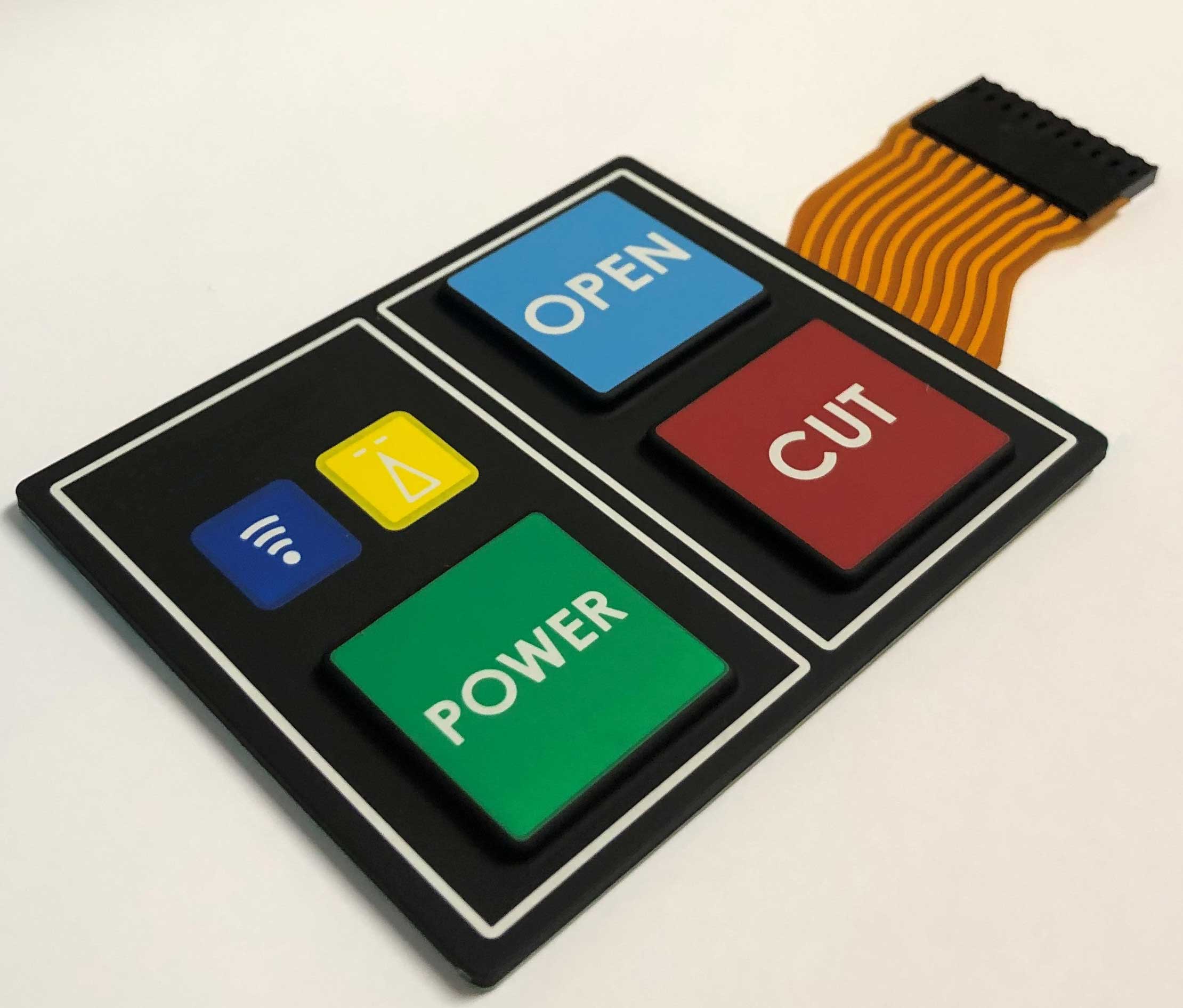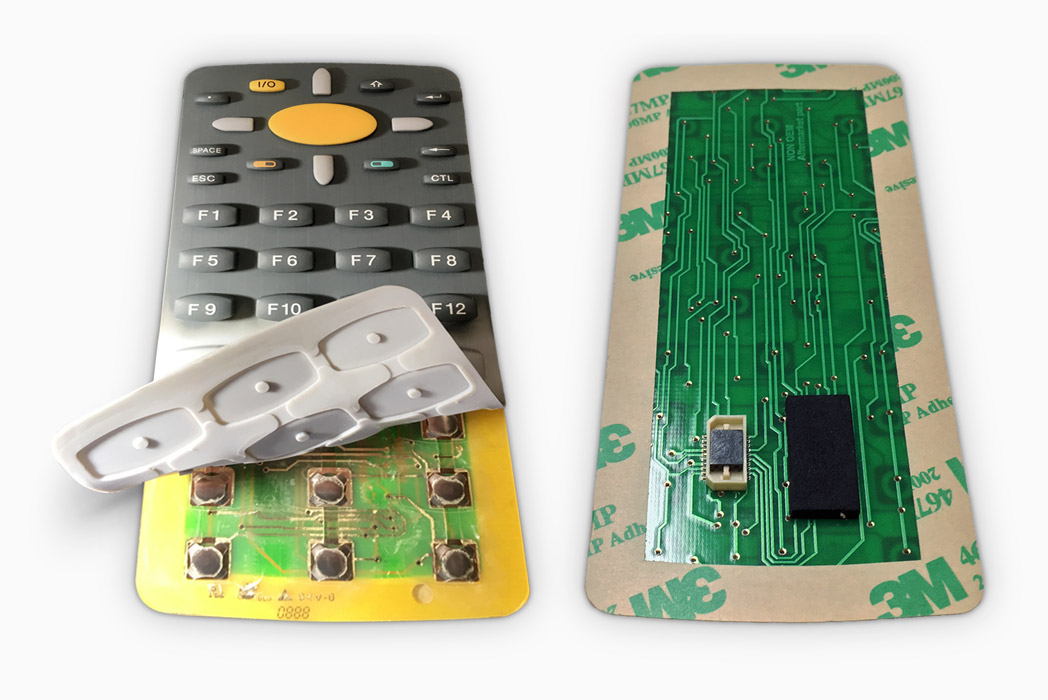Why silicone rubber is the top pick for most Rubber Keypads
Wiki Article
A Comprehensive Overview to the Manufacturing and Processing of Rubber Keypads for Ideal Performance
The production and handling of rubber keypads play a necessary duty in their efficiency and use. Material selection, layout precision, and innovative manufacturing techniques substantially impact their durability and effectiveness. Recognizing these elements is vital for developing top notch products. As various innovations arise in this field, exploring their implications could disclose new criteria for performance and user experience. What crucial aspects will shape the future of rubber keypads?Comprehending Rubber Keypads: Products and Kinds
Rubber keypads are crucial parts in many devices, offering a balance of longevity and tactile responses. These keypads are mainly made from silicone or synthetic rubber, products picked for their adaptability and resilience. Silicone rubber, specifically, is preferred for its superb temperature resistance and longevity, making it perfect for different applications, from consumer electronic devices to commercial machinery.There are numerous kinds of rubber keypads, consisting of dome switch keypads, which make use of a dome-shaped device that offers responsive feedback when pushed. In addition, there are additionally level keypads, which feature a smooth surface and are usually made use of in remotes and medical tools. The choice of material and type influences the keypad's efficiency, really feel, and general customer experience. Comprehending these facets is important for developers and makers aiming to produce effective and reliable interfaces in their products.
The Manufacturing Process: From Layout to Manufacturing
The manufacturing process of rubber keypads involves several important phases, starting with layout and finishing with manufacturing. Designers produce detailed requirements and models, assuring the keypad satisfies useful and aesthetic demands. Computer-aided layout (CAD) software application is often made use of to visualize the layout and features prior to continuing.Once the layout is settled, product choice is essential, with choices typically including silicone or natural rubber. In the following stage, molds are created based upon the accepted layouts, which will certainly shape the keypads throughout manufacturing.
Complying with mold and mildew development, the production phase starts, where rubber is blended with additives to boost performance. The combination is then put into mold and mildews and based on warm and stress, enabling it to treat and solidify.
The finished keypads go through top quality checks to confirm they meet well-known criteria, complied with by packaging for distribution. This all-inclusive procedure warranties peak performance in the end product.
Secret Methods in Rubber Molding
In the domain name of rubber keypads, various molding techniques play a pivotal function in identifying the high quality and functionality of the end product. One widespread approach is compression molding, where raw rubber is placed in a warmed mold and mildew and stress is used, enabling efficient mass manufacturing and harmony. One more substantial method is injection molding, which includes infusing warmed rubber right into a mold and mildew, supplying greater accuracy and complicated forms. Transfer molding, a crossbreed of both approaches, is likewise made use of, particularly for intricate designs, as it combines the benefits of both processes. In addition, liquid silicone rubber (LSR) molding is obtaining grip because of its adaptability and longevity, making it ideal for high-performance applications. Each method has special features, affecting factors such as cycle time, material waste, and manufacturing prices. Picking the appropriate molding method is essential for attaining peak efficiency in rubber keypads.Surface Area Finishing and Texturing Options
Surface ending up and texturing alternatives play an important role in enhancing the tactile experience and visual charm of rubber keypads. Producers use different methods to produce distinct surface area features that affect individual interaction and product design. Typical ending up techniques include matte, glossy, and satin surfaces, each using various visual impacts and grasp degrees. Texturing choices, such as increased patterns, grooves, or stippling, additionally boost functionality by enhancing grip and reducing slippage throughout use.Additionally, specific appearances can be tailored to satisfy ergonomic demands, giving comfort during long term usage. The option of surface area coatings and appearances can be influenced by the intended application of the keypad, whether it be for consumer electronic devices, auto controls, or commercial devices. Inevitably, mindful factor to consider of these choices contributes substantially to user complete satisfaction and total product performance, making them vital aspects in the design and production process of rubber keypads.
Quality Control Steps in Rubber Keypad Manufacturing
Quality assurance measures in rubber keypad manufacturing are vital for making certain product dependability and performance. These steps include material selection standards, strenuous screening procedures, and strict final assessment requirements. Together, they create a comprehensive framework that helps manufacturers copyright top quality throughout the production procedure.
Material Selection Standards
Selecting the proper products for rubber keypads is crucial, as it straight affects their user, longevity, and performance experience. Trick standards for material option include tensile toughness, durability, and environmental resistance. The selection of rubber compound, such as silicone or thermoplastic elastomer (TPE), plays an important role in attaining desired tactile responses and durability. Furthermore, aspects like chemical compatibility, temperature level stability, and UV resistance have to be considered to assure maximum performance in numerous applications. Suppliers ought to also evaluate the convenience of handling and cost-effectiveness of materials, balancing top quality with spending plan restrictions. Inevitably, the best product selection not just improves the keypad's performance yet additionally adds to overall product top quality and consumer complete satisfaction.Evaluating Procedures Applied
After figuring out the proper materials for rubber keypads, rigorous testing treatments are applied to verify that the final items meet sector standards and customer assumptions. These treatments usually include mechanical screening, which evaluates the toughness and elasticity of the rubber under numerous problems. Furthermore, environmental screening evaluates the keypads' performance under temperature level changes, humidity, and direct exposure to chemicals. Electric screening confirms the keypads work properly with digital parts, verifying responsiveness and conductivity. Responsive responses is evaluated to ensure user complete satisfaction. These extensive testing actions are crucial in identifying any kind of flaws or incongruities before automation, ultimately boosting the reliability and performance of rubber keypads in their designated applications.Final Evaluation Standards
Extensive final inspection standards are important in rubber keypad production to guarantee that each system meets the specified requirements for capability and appearance. This process commonly involves aesthetic assessments to recognize any type of surface issues, such as staining or imperfections. In addition, tactile examinations establish that the keypads respond accurately to touch, preserving the needed degree of sensitivity. Durability examinations might likewise be carried out, mimicing extended use to validate the longevity of the keypad under numerous conditions. Adherence to industry policies and client requirements is confirmed to preserve quality assurance. By executing these rigorous examination procedures, makers can substantially minimize the risk of issues, making sure that the final item is dependable and satisfies consumer expectations, inevitably enhancing customer satisfaction.Technologies in Rubber Keypad Technology
As technology remains to advance, developments in rubber keypad innovation are reshaping interface throughout numerous sectors. One substantial innovation is the combination of capacitive touch sensors within rubber keypads, enabling a much more responsive and versatile Recommended Site individual experience. This modern technology makes it possible for individuals to communicate with devices with touch, enhancing performance without sacrificing the responsive feedback that rubber keypads are understood for.In addition, improvements in material solutions have caused the development of more long lasting, weather-resistant rubber, making keypads suitable for outdoor and industrial use. Boosted printing strategies additionally allow for high-resolution graphics and backlighting options, boosting visibility and visual appeal.

Furthermore, innovations in manufacturing processes, such as 3D printing, are allowing custom-made designs and quick prototyping, enhancing manufacturing timelines. These developments collectively add to much more straightforward and effective rubber keypads, ensuring they satisfy the needs of modern applications while preserving their core benefits.
Ideal Practices for Layout and Functionality
Creating reliable rubber keypads calls for mindful assessment of both aesthetic appeals and capability. Rubber Keypads. look at these guys A well-designed keypad must balance ergonomic concepts with aesthetic charm to boost user experience. Secret variables include size, shape, and spacing of buttons, guaranteeing they are very easy to press while preventing unintentional activation. Using contrasting textures and colors can enhance exposure and tactile comments, helping individuals in distinguishing in between keysAdditionally, the option of materials plays an important duty; high-quality rubber compounds can enhance sturdiness and resistance to put on. It is also vital to think about the assimilation of features such as backlighting and custom graphics, which can boost use in numerous atmospheres.
Lastly, prototyping and user screening are vital in the style process, permitting adjustments based upon real-world comments. By sticking to these ideal methods, producers can create rubber keypads that not only look enticing yet also meet the useful requirements of individuals properly.
Frequently Asked Concerns
Just how Do I Select the Right Rubber Material for My Keypad?
To pick the best rubber material for a keypad, one ought to consider aspects such as durability, environmental resistance, responsive responses, and compatibility with the desired application, making sure perfect efficiency and customer complete satisfaction in various problems.What Are the Environmental Influences of Rubber Keypad Manufacturing?
Rubber keypad production can bring about ecological influences such as deforestation for natural rubber sources, contamination from chemical procedures, and waste generation. Lasting methods and products can minimize some of these negative effects on ecosystems.Can Rubber Keypads Be Recycled or Recycled?
Rubber keypads can be reused, yet the procedure relies on the particular materials utilized in their manufacturing. Recycling them in different applications is also possible, adding to squander decrease and advertising sustainability in producing techniques.What Is the Average Life Expectancy of a Rubber Keypad?
The ordinary life-span of a rubber keypad normally ranges from 5 to ten years, relying on usage, ecological elements, and upkeep. Normal treatment can expand its functionality, while too much wear may reduce its resilience.Are There Any Type Of Health Concerns Associated With Rubber Keypad Products?
There are possible health concerns associated to rubber keypad materials, including allergies to specific chemicals and toxic irritants utilized in manufacturing. Appropriate handling and recognition of product composition can mitigate these threats for customers.There are a number of types of rubber keypads, including dome button keypads, which use a dome-shaped device that offers responsive comments when pressed. Selecting the ideal products for rubber keypads is essential, as it directly affects their customer, performance, and resilience experience - Rubber Keypads. After identifying the ideal materials for rubber keypads, rigorous screening treatments are carried find out to confirm that the last products meet industry criteria and client assumptions. Rubber keypad production can lead to environmental effects such as logging for all-natural rubber resources, pollution from chemical procedures, and waste generation. Rubber keypads can be reused, however the procedure depends on the details products utilized in their production
Report this wiki page